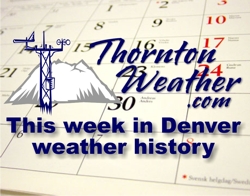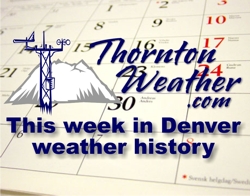
A typical week during the spring and summer for Denver – tornadoes, hail, damaging winds and more.
19-21
In 1875…smoke from several large forest fires in the mountains was visible from the city on each of these days.
20-21 in 1897…high winds raked the city overnight. Southeast winds were sustained to 60 mph with gusts as high as 72 mph on the 20th. Southeast winds were sustained to 57 mph with gusts to 60 mph on the 21st.
In 2007…a brief hot spell produced two temperature records. The high temperature of 97 degrees was tied on the 20th. A new record high temperature of 99 degrees was established on the 21st.
21
In 1927…north winds were sustained to 40 mph with gusts to 44 mph.
In 1984…lightning struck and killed two children standing near a tree in a backyard in Lakewood. Strong thunderstorm downbursts caused a wind gust to 58 mph in Northglenn and knocked down two power poles near Brighton.
In 1988…lightning struck a home in Denver…causing about ten thousand dollars damage. Lightning damaged 3 homes in Littleton…and also hit a house in greenwood village that had been struck by lightning 7 years previously.
In 1991…thunderstorms produced widespread hail across metro Denver. Hail as large as 2 1/2 inches fell at several locations across southwest metro Denver. One storm spotter reported hail 8 inches deep near the intersection of I-25 and C-470. Heavy rain with the storms caused some street flooding. In Commerce City…several cars were under water… And in Westminster a police officer reported water up to the doors of his car. Damage to homes and automobiles totaled 55 million dollars.
In 1992…a tornado touched down briefly near Bennett. Another tornado was briefly on the ground near Strasburg.
In 1994…heavy thunderstorm rains caused flooding in metro Denver. Several vehicles were stalled in the high water on I-25. Lightning struck an underground natural gas line in Aurora…causing a fire. Widespread power outages were also observed.
In 1996…three homes were struck by lightning in Parker. The lightning struck the garage of the first home…which started a small fire that burned some siding and spread into the attic. A second home sustained damage to the attic when a small fire was started. The third home received only minor damage. Lightning also sparked two small grass fires in the area. A man in Lakewood received minor injuries when he was struck by lightning while working on a ladder. A funnel cloud was sighted in Castle Rock. Strong thunderstorm winds downed a large tree near crossroads mall in Boulder. A small tornado (f0) briefly touched down near Lafayette. No damage was reported.
In 1997…one inch diameter hail was measured in Boulder.
In 2002…a thunderstorm wind gust to 62 mph was recorded at Denver International Airport.
In 2005…severe thunderstorms produced hail to 1 inch in diameter in Broomfield along with 3/4 inch hail near Arvada.
In 2006…a man riding a motorcycle was struck and killed by lightning on U.S. Highway 36 between church ranch Blvd. And Sheridan Blvd. In Westminster. After the biker was struck…he and his motorcycle crashed into the center concrete median of the highway. The lightning bolt left a crater in the highway asphalt that measured 18 inches long…8 inches wide and 4 inches deep.
Continue reading June 21 to June 27 – This week in Denver weather history

